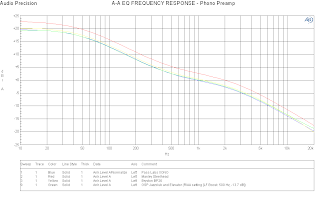Over the weekend I added the cartridges, Bryston BP26, and Cedar Duo Declickle to the equipment page on the project website.
http://coltrane.music.mcgill.ca/MAQ/equipment
Monday, May 10, 2010
Monday, May 3, 2010
Frequency response (*w/o additional RIAA curve*) for all 4 preamps. After reviewing the graph from the THD+N v. amplitude (along with the average output of the cartridges which will be used in future stages of this project), a comparison could be made by choosing an input voltage that was within the optimal input range of all the preamps. I therefore chose .5 mVrms. The output level references were chosen as relative measures for each device to produce approximately .5 Vrms from the input.
THD+N v. amplitude for all 4 preamps. Same color scheme and setup as the previous post (that demonstrated THD+N v. frequency). The tested range was 10uV - 10 mV, sufficent to test the range of possible input values for moving coil cartridges. The XONO and Steelhead had fairly similar traces, while the Bryston showed slightly greater noise and distortion than the XONO and Steelhead until approximately >750 uVrms, at which point the noise and distortion continued to decrease until the test neared its highest test value of 10 mVrms. The GSP setup (Jazzclub and Elevator [used for stepping up the amplification for MC cartridges]) followed a curve that was somewhat in between the others, however with significantly higher noise and distortion until approximately 1.5 mV.
Several trials were run to ensure that the curves were in fact being followed exactly as presented here. The Bryston volume knob setting was as in the previous post (i.e., adjusted until ~ .5 V output was produced from input voltage of .5 mV). The Elevator parameters were chosen to produce the lowest distortion/noise (r=high/c=high). Setting the Elevator to r=medium/c=medium and r=low/c=low resulted in only slightly higher distortion/noise within the entire range, following the same curvature.
As in the previous post:

Several trials were run to ensure that the curves were in fact being followed exactly as presented here. The Bryston volume knob setting was as in the previous post (i.e., adjusted until ~ .5 V output was produced from input voltage of .5 mV). The Elevator parameters were chosen to produce the lowest distortion/noise (r=high/c=high). Setting the Elevator to r=medium/c=medium and r=low/c=low resulted in only slightly higher distortion/noise within the entire range, following the same curvature.
As in the previous post:
- Blue = Pass Labs XONO
- Red = Manley Steelhead
- Yellow = Bryston BP26
- Green = GSP Audio Jazz Club w/ Elevator

Subscribe to:
Comments (Atom)
